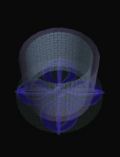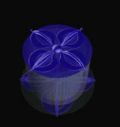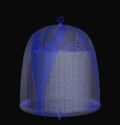Protective tent
The protective tent (Wyl. bsrung gur) and protective spheres (Wyl. bsrung 'khor) sometimes called "vajra tent", are meditated upon in Vajrayana sadhana practices to prevent any negative influence from entering the practice space. It is usually done after expelling the obstructing forces (Tib. gek) and preserved throughout the whole duration of the practice. The traditional example to illustrate this is of thoroughly locking oneself in after expelling thieves out of the house. There are the relative and the absolute protective tents.
Visualisation of protective spheres can be more or less elaborate. In its simplest form it is a vajra tent formed of a large crossed vajra with all the intervals filled with smaller vajras so that it is impenetrable. The following animation shows a more complex one, as described by Khenpo Chechok in his commentary to the Rigdzin Düpa sadhana.
Animation of the protection spheres
See the explanation below. (click on the yellow arrow in the right corner to play the animation)
<swf width="640" height="480">http://www.rigpawiki.org/Media/Video/ProtectionTent.swf</swf>
The animation can be downloaded by right clicking Protective Tent Animation and choose "save as".
The Relative Protection Spheres
Formation
Visualise that as the weapons of wrath and blazing masses of fire emanating from your heart meet those that come back after having expelled the negative forces, the vajra tent is formed, like molten metal as if poured into a cast [though there is no cast].
The ground

The ground is transformed into a great crossed vajra, with the spaces filled with smaller vajras.
The inner layer

Around the edge of the circular ground, now completely filled with vajras, without any space between them, is a hard and solid circle of vajras positioned vertically, again with the intervals between them filled with smaller ones.
The outer layer: the net of vajras

Outside this is a net of vajras interlaced in squares, the prongs parallel to the circumference.
The Vajra Canopy

On top of this net is the vajra canopy, which is formed from a big double vajra, the spaces between filled with tiny vajras. At the tips are half vajras rising outwards.
The intermediate layer
In the space between the first and second layers of the tent (the circle of vajras positioned vertically and the net of vajras interlaced in squares), there is another net of vajras, hanging down from the top, so that the whole thing looks like a closed cup.
The Vajra Tent

Above this canopy is the vajra tent. In the middle at the top is a crossed vajra, the four parts sloping down, and the spaces filled with tiny vajras as before. It covers all the prongs including those of the standing vajras like an iron helmet. On the summit is a blue vajra with spread prongs. Outside blaze the fires of the end of time.
The surroundings
Imagine that an infinite number of weapons of wrath spread outwards from the protective tent, and chase away all the negative influences.